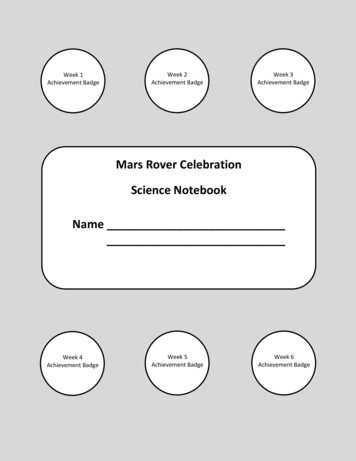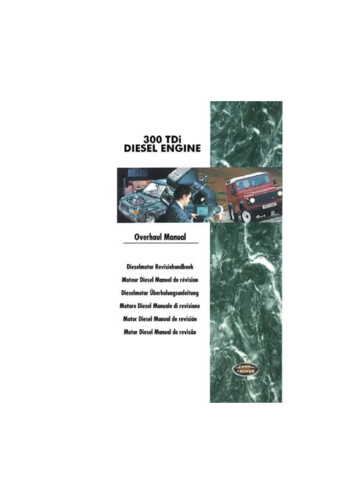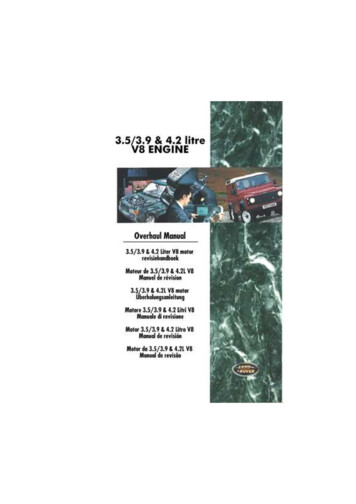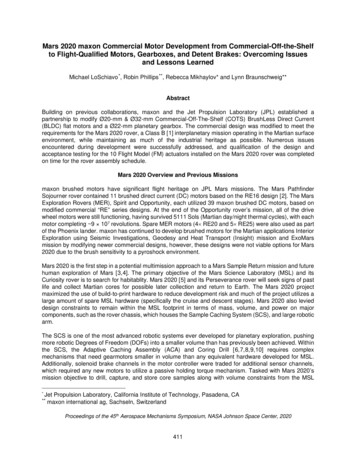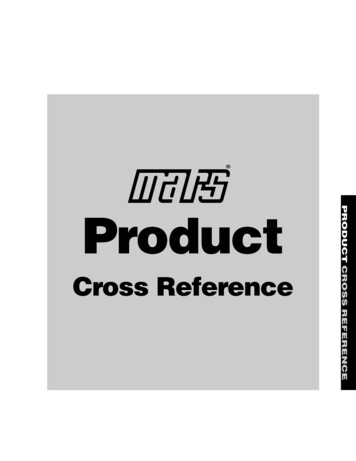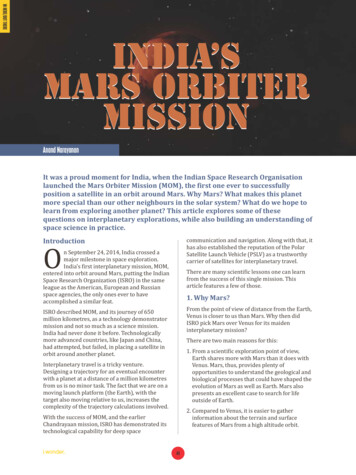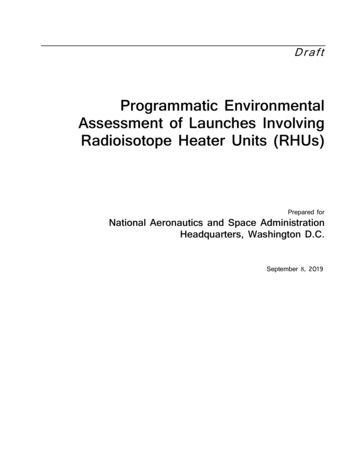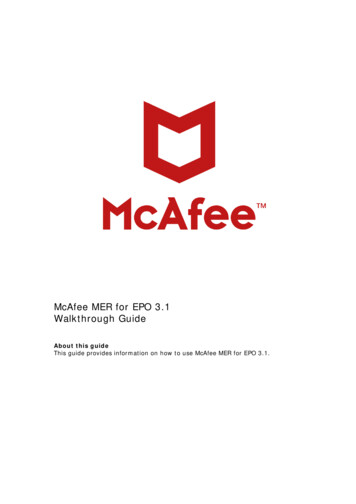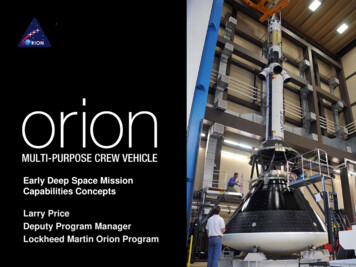
Transcription
JPL D-19658 Rev. CMER 420-1-200 Rev. CMars Exploration Rover (MER)ProjectArchive Generation, Validation andTransfer PlanRevision CRaymond E. ArvidsonSusan SlavneyJoy A. CrispApproved:Bruce Banerdt, MER Project ScientistJohn Callas, MER Project ManagerSteven Squyres, Athena Payload PrincipalInvestigatorEdwin Grayzeck, Planetary Data SystemProgram ManagerPaper copies of this document may not be current and should not be relied on for official purposes. Thecurrent version is in the MER Project Library at http://mars03-lib.jpl.nasa.gov, in the ControlledDocuments and Records folder.July 22, 2006Jet Propulsion LaboratoryCalifornia Institute of Technology
JPL D-19658 Rev. CMER 420-1-200 Rev. CCHANGE LOGDATESECTIONS CHANGEDREASON FOR itle page12/20/011.4 Applicable Documentsand ConstraintsTitle page2.1, Tables 1, 4, 52.2 Data FlowFirst draftIncorporated comments from DAWG;added discussion of validation, PlanetaryAtlas and Analyst's NotebookAdded signature line for Mission SystemManagerFixed incomplete referencesDraftAdded signature line for Science ManagerRemoved Suncam referencesRevised discussion of data release datesDraftDraftDraftRevised discussion of peer review inaccordance with new PDS policy ofbeginning review early, during designphaseChanged "Planetary Atlas" to "PDS OnlineServices" to reflect new services to beoffered by PDSReplaced section 4 with Table 6, MERArchive Generation, Validation, andRelease ScheduleRemoved NASA Level 1C, since not usedDraft12/20/0112/20/0112/20/0112/20/012.3 Data Validation and PeerReview12/20/012/18/022.4 Integrated Archives3.2 Planetary Data SystemResponsibilities4 Detailed ArchiveGeneration, Validation, andRelease SchedulesTable 2. Definitions ofProcessing Levels forScience Data SetsTable 3, Components of MERArchives, and Table 4, MERArchive ComponentSuppliers2.3 Data VolumeTable 5, MER Standard DataProducts2.2 Data Flow2/18/022/18/022.3 Data VolumeFig.13/22/02Section 3.3 ftDraftDraftRevised and expanded to make the twotables consistentDraftSection addedRemoved Data Volume columnDraftDraftDescribed OSS and SSS access and usefor storing EDRs and RDRs. Newrequirement for Project to deliver 3 copiesof archives on hard digital media to thePDS (consistent with the new MarsProgram Data Management Plan)Increased the total data volume estimateAdded a Figure showing the MissionTimelineAdded a sentence: NSSDC may alsoprovide support for distribution of MERdata to the general public, although this isbeyond the domain of this MER ArchiveGeneration, Validation, and Transfer Plan.DraftiiDraftDraftDraft
JPL D-19658 Rev. C5/12/032.2 Data Flow5/12/035/12/03Tables 3, 4, and 5Table 5, MER Standard DataProducts5/12/03Section 3.2 Planetary DataSystem Responsibilities6/25/03Section 2.2 Data Flow6/25/038/25/03Figure 1, Mission TimelineTable 5, MER Standard DataProductsSection 1.4, ApplicableDocumentsSection 2.2, Data FlowSignature cover page9/3/039/17/039/29/0312/29/03Section 3.2, Planetary DataSystem ResponsibilitiesSection 3.2 Planetary DataSystem Responsibilities12/29/03Tables 3, 4, 54/17/044/17/04Tables 1 and 3Table 14/17/04Section 2.24/17/04Acronyms Table4/17/04Section 2.14/17/04Sections 2.4 and 3.14/17/04Table 34/17/04Table 4MER 420-1-200 Rev. CAdded paragraph about delivery of specialproductsAdded specific rover engineering productsRevised to match John Callas' list ofstandard products; added NASAprocessing levelsRevised description of PDS Central Nodeparticipation based on comments fromPDS Mars Data EngineerRevised description of science teamaccess to data productsReplaced with revised timeline figureRevised to match John Callas' list (again)Rev. ARev. ARev. ARev. ARev. ARev. ARev. AAdded requirements for Data Product andArchive Volume SISsRev. AReplaced Jim Erickson, MER MissionSystem Manager, with Peter Theisinger,MER Project Manager as a signatoryClarified archiving of RDRs betweenImaging and Geosciences NodeAdded the Atmospheres Node for theInertial Measurement Unit data and theGeosciences Node for the radio sciencedata. Clarified the responsibility forarchiving EDRs to include Science Team.Put the responsibility for making hardcopy (DVDs) of the archives on theProject.Added the Atmosphere structure data andradio science data to the tables.Added the Descent cameraCorrected the camera parameters forHazcam, Navcam, and PancamExplained the different kinds of EDRs,who would generate the EDRs and RDRs,and where they would be stored. Deletedthe reference to the MIPL AlternateStorage Server (MASS)Removed acronyms from the list no longerused in the documentUpdated the mission description,changing to the past tense, and includingdates.Removed all mention of the Science DataValidation Team (SDVT). We will not usean SDVT.Deleted Science Theme GroupDocumentarian NotesDeleted RAT RDRs and Science ThemeRev. AiiiRev. ARev. BRev. BRev. BRev. BRev.BRev. BRev. BRev. BRev. BRev. B
JPL D-19658 Rev. C4/17/04Table 54/17/04Table 6 and Section 2.24/21/04Acronyms Table4/21/04Table 45/11/04Table 56/11/04Table 56/17/04Table 56/17/046/17/047/2/04Table 4Table 3Table 47/2/04Cover page7/2/04Table 5 (now called Table 4)7/2/04Table 37/14/04Applicable Documents7/14/047/14/04TBD ItemsTable 5MER 420-1-200 Rev. CGroup Documentarian Notes. AddedPancam and MI Science EDRs.Added Operations Uplink Information(Tables of science features and targets,and tables of uplink plans and roveractivities accomplished).Made it more clear that the Third ArchiveRelease will be due 6 months after thelast data are received.Corrected the definition of the SPICEacronymChanged the primary responsibility forEngineering Camera RDRs to J. Maki.Changed the responsibility for Mini-TESEDRs to P. ChristensenRemoved E Kernels, added FK, LSK,SCLKRemoved Mini-TES mineral map specialproductsUpdated the table of data products to beconsistent with the list of PDS datasetsAdded OPGS RDRsAdded OPGS archivesRemoved the old Table 4 (MER ArchiveComponent Suppliers). This informationis now a part of what used to be Table 5and is now Table 4 (MER Data Products)Changed Project Manager to JimErickson, added Joy Crisp as a coauthorReplaced the information in this table witha more detailed listing of every individualdata product, its producer, curator, dataset ID, controlling document, archivevolume producer, and volume ID.Removed International Traffic and Arms(ITAR) sensitive products from the tablesince we have determined that we cannotarchive them in the PDS. These productsare: Rover engineering telemetry, Rovermobility reports, and Rover operationsdocuments. Changed RS in the DataProduct ID for Radio Science to RSS.Removed Engineering Data Archives, dueto ITAR considerations.Replaced Planetary Data System DataPreparation Workbook, which is beingphased out, with the PDS Data DictionaryDocumentRemoved the TBD table.Replaced launch window dates with actuallaunch datesivRev. BRev. BRev. BRev. BRev. BRev. BRev. BRev. BRev. BRev. BRev. BRev. BRev. BRev. BRev. BRev. B
JPL D-19658 Rev. C7/14/04Table 41/6/061/6/061/6/06Cover page1.4 Applicable Documents;2.2 Data Flow; 3.3 NationalSpace Science Data CenterResponsibilities2.2 Data Flow; Table 3Components of Mer ArchivesTable 4 MER Data Products7/20/067/20/06Cover pageTable 4 MER Data Products7/22/06Table 41/6/06MER 420-1-200 Rev. CUpdated the Data Product IDs to beconsistent with the products beingprepared for the PDS archivesUpdated name and title of PDS signatoryRevised text to mention PDS-NSSDCMOURev. BRev. CRev. CMinor editsRev. CRevised some document names, data setIDs, and volume IDs. Changed ArchiveVolume Producer from MIPL to GEO for 4data sets. Deleted MB CALSPEC data setbecause it has been combined with theSUMSPEC data set.Changed signatoriesAdded a rover mobility product, addedasterisks next to special products that arenot archived on the same schedule as theother products. Added a footnote to thetable: ** Special products are not on thesame schedule as the standard products.Our goal is to have preliminaryMoessbauer mineralogical analysis tablesand APXS chemical concentrationsavailable on the PDS 3 months after thecorresponding EDRs are delivered, andPDS-compliant versions available 6months after the corresponding EDRs aredelivered. The schedule for other specialproducts is on a best-efforts basis.Changed data producer for EDLAtmosphere RDRs from David Kass totbd.Rev. CMade several corrections to data set IDsand archive volume IDsvRev. CRev. CRev. C
JPL D-19658 Rev. CMER 420-1-200 Rev. CCONTENTSCHANGE LOG .iiCONTENTS .viFIGURES .viTABLES .viACRONYMS .vii1. INTRODUCTION. 81.1 Purpose . 81.2 Scope . 81.3 Contents . 81.4 Applicable Documents and Constraints . 82. MER ARCHIVE GENERATION, VALIDATION, AND TRANSFER TO THE PDS . 92.1 The Mission . 92.2 Data Flow . 102.3 Data Volume . 112.4 Data Validation and Peer Review . 112.5 Integrated Archives. 122.5.1 PDS Online Services. 122.5.2 The Analyst's Notebook . 123. ROLES AND RESPONSIBILITIES. 123.1 Mars Exploration Rover Project Responsibilities . 123.2 Planetary Data System Responsibilities . 133.3 National Space Science Data Center Responsibilities. 14FIGURESFigure 1. Mission Timeline for June 2003 – May 2004 . 15TABLESTable 1. MER Athena Rover Payload and Engineering Cameras . 16Table 2. Definitions of Processing Levels for Science Data Sets . 18Table 3. Components of MER Archives . 19Table 4. MER Data Products. 20Table 5. MER Archive Generation, Validation, and Release Schedule . 27vi
JPL D-19658 Rev. CMER 420-1-200 Rev. LNAIFNSSDCOSSPDSRATRDRRPIFSISSOWGSPICETBDVPNAlpha Particle X-ray SpectrometerData and Archives Working GroupExperiment Data RecordField of ViewGround Data SystemJet Propulsion LaboratoryLocal Area NetworkMössbauer SpectrometerMars Exploration RoverMicroscopic ImagerMiniature Thermal Emission SpectrometerMulti-mission Image Processing LaboratoryNavigation and Ancillary Information FacilityNational Space Science Data CenterOperations Storage ServerPlanetary Data SystemRock Abrasion ToolReduced Data RecordRegional Planetary Image FacilitySoftware Interface SpecificationScience Operations Working GroupSpacecraft, Planet, Instrument, Pointing C-matrix, and Event kernels (historicalacronym for navigation and ancillary data)To Be DeterminedVirtual Private Networkvii
JPL D-19658 Rev. CMER 420-1-200 Rev. C1. INTRODUCTION1.1 PurposeThe purpose of this document is to provide a plan for generation, validation, and transfer to thePlanetary Data System (PDS) of archives from the 2003 Mars Exploration Rover (MER)Mission. The archives will contain raw and reduced data, documentation, and algorithms orsoftware.1.2 ScopeThe plan covers archiving of raw and reduced data sets and related information to be acquired orderived during the MER mission.Specific aspects addressed in this plan are: Generation of high-level mission, spacecraft and instrument documentation, instrumentcalibration reports, and documentation of algorithms and/or software used to produce reduced data records. Reduction of science packet data to reduced data records, including generation of data setsexpressed in geophysical units, with associated documentation that records when and wherethe data were acquired and for what purpose. Generation of SPICE archives for use with software from the Jet Propulsion Laboratory'sNavigation and Ancillary Information Facility (NAIF). Generation and validation of archive volumes containing MER science and engineeringdata, software, algorithms, documentation, and ancillary information. Delivery to the PDS of validated MER archives.1.3 ContentsThis plan begins with a summary of MER mission phases and an overview of the archiving flow.This section is followed by a description of the roles and responsibilities for organizations andpersonnel associated with generation, validation, and archiving of MER data. The document endswith specific archiving plans.1.4 Applicable Documents and ConstraintsThis Archive Generation, Validation, and Transfer Plan is responsive to the following MarsExploration Program and MER documents:1. Mars Exploration Program Data Management Plan, R. E. Arvidson and S. Slavney, Rev.3, March 20, 2002.2. Mars Exploration Rover Project Plan, P. C. Theisinger, MER 420-1-100, JPL D-19374.3. Mars Exploration Rover Mission Plan, J. Ludwinski, MER 420-1-300, JPL D-19659.8
JPL D-19658 Rev. CMER 420-1-200 Rev. C4. Mars Exploration Rover Project Athena Science Implementation Plan, S. Squyres, MER420-1-201, JPL D-20458.5. Mars Exploration Rover Project Science Management Plan, J. Crisp, MER 420-1-103,JPL D-19637.6. Mars Exploration Rover Analyst's Notebook Functional Requirements Document, E. A.Guinness et al., Draft 1.0, April 26, 2001.The plan is consistent with the principles delineated in the following National Academy of Sciences reports:7. Data Management and Computation, Volume 1, Issues and Recommendations, 1982,National Academy Press, 167 p.8. Issues and Recommendations Associated with Distributed Computation and DataManagement Systems for the Space Sciences, 1986, National Academy Press, 111 p.The plan is also consistent with the following Planetary Data System documents:9. Planetary Science Data Dictionary Document, August 28, 2002, JPL D-7116, Rev. E.10. Planetary Data System Data Standards Reference, June 15, 2001, Version 3.4, JPL D7669, Part 2.11. Memorandum of Understanding between National Space Science Data Center and thePlanetary Data System, March 1, 1988. (to be revised)The plan requires the generation of the following Project documents:12. Data Product Software Interface Specification (SIS) for all Standard Products.13. Archive Volume Software Interface Specification (SIS) for all Standard Products.Finally, the plan is meant to be consistent with the contract negotiated between the MER Projectand the Athena Principal Investigator (PI) in which reduced data records and documentation areexplicitly defined as deliverable products.2. MER ARCHIVE GENERATION, VALIDATION, AND TRANSFER TOTHE PDS2.1 The MissionThe Mars Exploration Rover Mission consisted of two launches of identical spacecraft June 10,2003 and July 7, 2003, with placement of a lander and rover in two different localities on Marson January 3 and 25 of 2004. Each rover conducted traverses and acquired scientific data usingthe Athena payload and rover engineering systems. Each rover operated for a 90-sol primarymission, with an extended mission of unknown duration (both rovers are still in operation at thetime of writing of this document). Figure 1 shows the mission timeline, as it was understoodpre-landing.The two identical flight systems each consisted of a cruise stage, an entry, descent, and landingsystem, and a rover. The Athena Payload on each rover included a mast-mounted stereo colorpanoramic imager (Pancam) and a mid-IR spectrometer (Mini-TES), arm-mounted Mössbauer9
JPL D-19658 Rev. CMER 420-1-200 Rev. Cand Alpha Particle X-ray Spectrometers (MB and APXS), a microscopic surface imager (MI),and a Rock Abrasion Tool (RAT). Navigation and hazard avoidance cameras were also includedon the rover. Table 1 summarizes the MER rover payload and Descent Camera. In addition,physical properties experiments were conducted using the rover wheels to dig into soils andcharacterizing the exposed materials with the Athena instruments.2.2 Data FlowAs part of the MER Ground Data System (GDS), the JPL Multi-Mission Image ProcessingLaboratory (MIPL) have generated Experiment Data Records (EDRs) from telemetry data fromthe Athena science instruments. Members of the Science Team also have generated EDRs forPancam and Microscopic Imager using slightly different processing, as described in the CameraEDR/RDR SIS; these products are called “Science EDRs.” Both MIPL and Science Teammembers have generated Reduced Data Records (RDRs) for some instruments. Table 2 definesprocessing levels associated with Reduced Data Records. MIPL-generated EDRs and RDRs willbe stored on the MER Operations Storage Server (OSS). EDRs and RDRs generated by theScience Team members will also be stored on the OSS.EDRs and RDRs will be generated according to designs specified in Data Product SoftwareInterface Specification (SIS) documents. Every MER standard product is described in a DataProduct SIS.Access to the OSS is restricted by a network firewall to users on workstations within the MissionSupport Area Flight LAN. Users outside the network firewall may use FEI (File ExchangeInterface) subscriptions or Smart Cards (and VPN, if outside of the JPL Institutional network) toaccess files on the OSS. For analysis performed outside of the network firewall, science teammembers may download EDR and RDR products for processing using the Image Atlas front-end(web page). RDRs intended to support operations may be uploaded to the OSS, as necessary viaFEI or SSH using Smart Cards.The Analyst Notebook (AN) will be the repository for externally produced science data productsto be archived with PDS. The AN will contain additional archive materials such asdocumentation, software, calibration data, engineering data, and SPICE kernels. Table 3 lists thehigh-level elements that comprise the MER archives and Table 4 provides a detailed list of allthe data sets.The MER Project is required to generate, validate, and deliver relevant mission raw and deriveddata and supporting documentation to the Planetary Data System within six months of dataacquisition. In keeping with this requirement, the MER Project will deliver to the PDS twointegrated archives for each rover mission, the first one no later than six months after Sol 30 dataare received on Earth, and the second one no later than six months after Sol 90 data are receivedon Earth. For the extended rover missions, a third release will occur no later than six monthsafter the last data from the extended mission are received on Earth. Table 5 shows the dates forarchive data acquisition and release.In addition to the standard products in Table 4, special products may be generated by some datasuppliers as time and other resources permit. Some of these special products are listed in Table 4with double-asterisks. Those special products that are completed and validated in time for ascheduled release to PDS may be delivered along with the standard products. PDS will continue10
JPL D-19658 Rev. CMER 420-1-200 Rev. Cto accept special products after the end of the mission as long as they are documented andvalidated according to PDS standards.Payload Element Leads are responsible for preparing data from their payload elements, alongwith supporting materials, for release to the PDS. A data release may take the form of electronictransfer or delivery on physical media to the appropriate PDS Node (section 3.2). PDS personnelwill work closely with science team members to ensure a smooth transfer. When data productshave been released to the PDS, they are regarded as publicly available. It is expected that thedata will be made available to the public online through the PDS online distribution system, andin the form of an Analyst's Notebook (section 2.5).All MER archive collections will be assembled according to designs specified in ArchiveVolume Software Interface Specification (SIS) documents.Although online access will be the primary distribution method for MER archives, the PDSrequires that archives be stored on appropriate physical media (e.g. CDs, DVDs) for long-termmaintenance at the PDS and at the National Space Science Data Center (NSSDC). PDS isresponsible for delivering a copy of MER archives to NSSDC according to the agreementbetween PDS and NSSDC (Applicable Document 11).2.3 Data VolumeFor planning purposes, the total downlinked data volume from both rovers is estimated atapproximately 4 Gigabytes for the primary mission, based on sample mission scenarios. Thetotal volume of EDR products after decompression is estimated to be the downlink volume times16. The total volume of RDR products is not yet determined, but could be as much as 25 timesthe EDR volume, which would correspond to a total archive data volume (EDR and RDR) of 1.6Terabytes. Extremely optimistic outcomes could result in twice as much downlinked data.2.4 Data Validation and Peer ReviewMER science archives will be validated before being released to the PDS. Validation isaccomplished in two parts: validation for scientific integrity and validation for compliance withPDS standards. Science team members are expected to conduct validation for scientific integrityin the course of their analysis of EDRs and their production of RDRs. The details of the sciencevalidation process are the responsibility of the Payload Element Leads.Validation for compliance with PDS standards is also the responsibility of each Payload ElementLead, with help from the PDS Node that will receive the data products. PDS will providesoftware tools, examples, and advice to help make this part of the validation as efficient aspossible. This validation includes a peer review of the design and labeling of data products aslaid out in the Data Product Software Interface Specification (SIS) documents, and validation ofthe PDS labels using sample data. The review will take place well before the start of operations,to allow sufficient time to correct problems. Reviewers will consist of a small group of scientistswho represent typical users of the data; for example, Participating Scientists would be goodcandidates for reviewers. After the start of operations, when generation of standard products hasbegun, each individual product will be validated to see that it conforms to the design specified inthe SIS. Validation of individual products will be automated as much as possible.11
JPL D-19658 Rev. CMER 420-1-200 Rev. C2.5 Integrated ArchivesThe concept of integrated archives is the key to making the best use of the data returned by thevarious science instruments on MER. Unlike previous orbital and landed missions in whichinstruments were operated mostly independently of one another, in a rover mission theinstruments must operate in close coordination. Furthermore, a rover mission is nondeterministic; a decision to conduct a sequence of observations may be driven by recentlyacquired data rather than by a plan determined in advance. The Athena Team and the generalscience community will require access to science data archives that are integrated acrossinstruments by time, by location, and by observation target, at a minimum. Two complementarysystems, PDS online services (such as the Planetary Image Atlas) and the Analyst's Notebook,will provide the desired accessibility.2.5.1 PDS Online ServicesPDS will offer a Web-based system of access to MER science data products. It will allowselection based on various search criteria, browsing of data, and downloading in various formats.A version of the online system adapted specifically to the needs of the MER mission will beavailable for use by mission personnel. The system can also be used by the general sciencecommunity to view and download data products that have been made public.2.5.2 The Analyst's NotebookThe Analyst's Notebook is a Web-based tool for correlating data products from various Athenainstruments based on time, location, observation target, and other criteria. The Notebook willprovide detailed views into operational decisions, results, and access to raw and derived data andinstrument calibration information. Using the Notebook, a scientist can virtually replay missionevents to better select and understand data products of interest. The Analyst's Notebook will bedesigned and implemented by the Deputy Principal Investigator at Washington University, basedin part on the Experimenter's Notebooks built to support analyses of data collected during theFIDO rover field trials. The Analyst's Notebook is a deliverable to the MER Project.The PDS Atlas and the Analyst's Notebook are intended to be complementary tools. The Atlaswill probably be used to satisfy most requests for locating and downloading data products byMER mission personnel and the general science community. The Analyst's Notebook willprobably be used by a smaller set of scientists who need access to the most detailed informationavailable about the data.3. ROLES AND RESPONSIBILITIESIn this section the roles and responsibilities for personnel and organizations involved in MER archive generation, validation, transfer, and distribution are summarized.3.1 Mars Exploration Rover Project ResponsibilitiesThe MER Project has overall responsibility for generation and validation of archives for releaseto the PDS. The Project is also responsible for distribution of data and associated information toMER personnel.12
JPL D-19658 Rev. CMER 420-1-200 Rev. CThe Project Scientist co-chairs the Project Science Group and provides oversight of the archivingprocess from a science perspective. The Project Scientist will review data analysis plans toassure timely and adequate analysis of spacecraft data and delivery of documented, completedata to the PDS. The MER Science Manager is responsible for the administrative managementof data archive planning and implementation.The Data and Archives Working Group (DAWG) will coordinate the planning of the generation,validation, and release of PDS-compliant archives to the PDS. The DAWG is a subgroup of theMER Project Science Group and reports to the PSG Co-Chairs (MER Project Scientist and MERProgram Scientist). The DAWG Chair is the MER Interdisciplinary Scientist for Data andArchives (also the Athena Deputy Principal Investigator). DAWG membership includes theMER Project Scientist, the Athena Principal Investigator and Payload Element Leads,representatives from NAIF and MIPL, and project personnel selected to ensure that raw packets,engineering data sets, and documentation are included in archives. Representative PDS personnelwill be liaison members of the DAWG. For the most part, the DAWG's work will take placebefore mission operations begin. During the active mission the DAWG will meet whennecessary.MIPL is responsible for generating validated, PDS-compatible archives containing ExperimentData Records (Level 0) from the Athena science instruments.The Athena Principal Investigator is responsible for generating validated, PDS-compatiblearchives containing derived data products (Level 1 and above) from Athena data, along withdocumentation, algorithms or software for generating derived data products, calibration data andreports, and other supporting materials.3.2 Planetary Data System ResponsibilitiesThe PDS is the designated point of contact for MER on archive-related issues. The PDS is alsothe interface between MER and the National Space Science Data Center (NSSDC). The PDS willwork with the DAWG to ensure that the MER archives are compatible with PDS standards andformats. Personnel from the PDS Geosciences, Imaging, Atmospheres, NAIF and Central Nodeswill be liaison DAWG Members.The PDS will provide funds for generation, distribution, and maintenance of MER archives forthe NASA planetary science community once the archives have been released by MER.Primary responsibility for archiving will be shared between the PDS Geosciences and ImagingNodes, as follows. The Geosciences Node will provide overall coordination of PDS activities forMER. The Imaging Node will work with MIPL and the Science Team to archive EDRs from allAthena science instruments, both imaging and non-imaging instruments. The Imaging andGeosciences Node will work together to archive RDRs from all Athena science instruments as aset of integrated archives using the PDS online services (e.g.,
Removed NASA Level 1C, since not used Draft 1/15/02 Table 3, Components of MER Archives, and Table 4, MER Archive Component Suppliers Revised and expanded to make the two . VPN Virtual Private Network vii . JPL D-19658 Rev. C MER 420-1-200 Rev. C 1. INTRODUCTION
